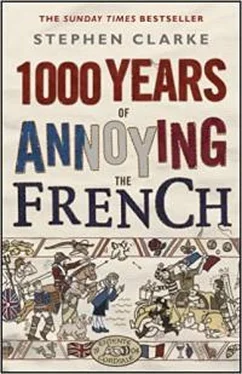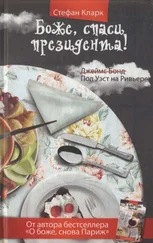Стефан Кларк - 1000 Years of Annoying the French
Здесь есть возможность читать онлайн «Стефан Кларк - 1000 Years of Annoying the French» весь текст электронной книги совершенно бесплатно (целиком полную версию без сокращений). В некоторых случаях можно слушать аудио, скачать через торрент в формате fb2 и присутствует краткое содержание. ISBN: , Издательство: Transworld Digital, Жанр: Старинная литература, на английском языке. Описание произведения, (предисловие) а так же отзывы посетителей доступны на портале библиотеки ЛибКат.
- Название:1000 Years of Annoying the French
- Автор:
- Издательство:Transworld Digital
- Жанр:
- Год:неизвестен
- ISBN:9781407067629
- Рейтинг книги:3 / 5. Голосов: 1
-
Избранное:Добавить в избранное
- Отзывы:
-
Ваша оценка:
- 60
- 1
- 2
- 3
- 4
- 5
1000 Years of Annoying the French: краткое содержание, описание и аннотация
Предлагаем к чтению аннотацию, описание, краткое содержание или предисловие (зависит от того, что написал сам автор книги «1000 Years of Annoying the French»). Если вы не нашли необходимую информацию о книге — напишите в комментариях, мы постараемся отыскать её.
1000 Years of Annoying the French — читать онлайн бесплатно полную книгу (весь текст) целиком
Ниже представлен текст книги, разбитый по страницам. Система сохранения места последней прочитанной страницы, позволяет с удобством читать онлайн бесплатно книгу «1000 Years of Annoying the French», без необходимости каждый раз заново искать на чём Вы остановились. Поставьте закладку, и сможете в любой момент перейти на страницу, на которой закончили чтение.
Интервал:
Закладка:
The French, on the other hand, were characteristically late for the battle, and when Philippe VI got to Crécy, most of his army still hadn’t arrived. One of his advisers told him that there was no point fighting that day, because the troops would be tired and, besides, it had been raining and some of the knights had water trickling down inside their armour and it was just too, too uncomfortable. Philippe, who, as we have seen, was never averse to avoiding a battle if he could do so, gave the order to make camp.
What Philippe didn’t realize, because summer holidays hadn’t yet been invented, was that the last weekend in August is absolute hell on French roads. Hordes of knights, footsoldiers and peasants were surging along all lanes leading to Crécy, and began to cause such a logjam that the front line of Philippe’s army, the Genoese crossbowmen, had no choice but to advance to avoid the crush.
These poor Italians (who obviously hadn’t been warned by their compatriot, the sailor Barbanera, about bad French organization) were the first victims of Edward’s arrow storm, and have been feeling the brunt of French resentment ever since.
They marched across rain-soaked terrain, straight uphill towards the longbowmen, having to stand still for up to a minute every time they wanted to reload their cumbersome crossbows. What’s more, during their long trek to the battlefield, the Genoese had left their shields on the baggage carts in the rear, and hadn’t been able to go back and fetch them. The English and Welsh longbowmen saw the first wave of attackers lumbering forwards and simply slaughtered them, their arrows tearing through leather jerkins, piercing helmets and slicing holes in faces.
The Genoese were mercenaries, and, just like Barbanera at the Battle of Sluys, seem to have had a collective bout of ‘sod this job’. They turned and fled – or tried to. There was nowhere to flee, because they were being followed by massed ranks of French cavalry.
Some French sources forgive the Genoese – one chronicle goes as far as to say that they were handicapped because their crossbow strings had gone limp in the rain – but most are unforgiving. They report the fury of Philippe VI’s brother, Charles de Valois, who, seeing this unchivalrous retreat, ordered his cavalry to ‘stomp the rabble’. Some even accuse the Genoese of turning on the French, drawing knives and trying to cut horses’ sinews and knights’ throats. One thing is for certain, though: Edward’s archers were now firing at will on a helpless mob of panicking crossbowmen, stumbling horses and indignantly snorting French nobles. Philippe’s royal brother Charles himself rode at the crossbowmen, got tangled up in the mound of bodies and was probably killed within minutes of entering the battle.
Fired up with pride, shoved in the back by the arriving mob, and urged on by tuneless music, the French knights just kept on coming. In complete disarray they rode or marched into the hailstorm of arrows, which, according to the chronicler Froissart, was so dense that it blacked out the evening sun.
Edward and his army must have wondered what was going on. At least the townspeople of Caen had thrown a few stones and rooftiles at them. These knights, the ‘flower of France’, were simply queuing up to be slaughtered.
The Black Prince and some white feathers
One of the most famous stories to emerge from the battle tells of a blind knight who insisted on charging to his death. King John of Bohemia, an ally of Philippe, had lost his sight owing to an eye infection caught while fighting in Lithuania, but didn’t want to miss out on the excitement at Crécy. So he ordered his men to tie his horse’s reins to theirs and pull him in the direction of the English lines. What he hoped to do if he got there is anyone’s guess – ask the archers to shout out and give him a sporting chance of hitting them, perhaps. In any case, John’s group somehow made it to the top of the slope, where they were all cut down by English men-at-arms.
The French charged up that hill over a dozen times, and even their own chronicler, Froissart, remarks on their total lack of discipline. Only when darkness fell did Philippe accept defeat and, sporting a wound that some sources place on his neck, others on his thigh ( cou and cuisse are fairly similar words, after all), rode away to a nearby chateau, where he called out for the gateman to open up to the ‘unfortunate King of France’. This, believe it or not, was a joke, because up until then he had been known as Philippe the Fortunate. Like his jester six years earlier, Philippe probably didn’t get a laugh.
Medieval illustrators were never very reliable on exact troop numbers or perspective, but the general gist is right: British archers start wreaking havoc at Crécy in 1346.
It wasn’t until the following morning that the English discovered the full extent of their victory. Exhausted, they had slept in their battle formations, and awoke to find the whole valley full of fog. It can’t have been a silent night – the wounded men and horses must have been groaning pretty loudly – but even Edward was shocked when his scouts reported back that the field was a huge mass of dead Frenchmen (with some Genoese at the bottom of the pile).
Edward quickly sent out more men to identify the dead. This was the cue for the knifemen to make sure that anyone not rich enough to hold for ransom, or too severely wounded to be taken prisoner, was actually dead. To do this, they used a long, thin blade called a misericorde or ‘mercy-giver’, which could be thrust between armour plates, into unprotected armpits or through visor slits, to pierce a knight’s heart or brain.
The Black Prince went to view the carnage after his first battle, and was shown blind King John and the clutch of Bohemian bodies, still bound together in death. He was so moved that he stole (or perhaps should one say adopted) John’s three-white-feather crest and his motto, ‘Ich dien’ – ‘I serve’. 5
By the end of the body count, the English had tallied up 1,542 dead French noblemen and an estimated 10,000 other ranks.
The 10,000 didn’t bother the French so much, but the list of defunct aristocrats included various Henris and Louis and Charles, who were the crème de la crème de la crème of France. And the most shocking thing to the French was that almost all of them had been killed by archers or knifemen, what one chronicler bluntly calls ‘gent de nulle valeur’ – people of nil value. It was as if the French rugby fifteen had just lost to half a dozen boozed-up Big Issue sellers. Predictably, everyone blamed the team coach, Philippe VI. And his disastrous season was only just beginning …
A quick stop for some burghers
Whatever their name might suggest, the Burghers of Calais are not items on a cross-Channel ferry menu. They are French heroes, created just after Crécy. However, as with so many of France’s heroes, including the soon-to-appear Joan of Arc, there is a French version of the story, and a true one.
The French version is that in 1347 these six citizens of Calais saved their town from the English. The truth is that they lost it.
The French would also have us believe that the burghers offered themselves up to Edward III for execution in exchange for a promise that the town would be spared. What no one mentions is that these same burghers, rich representatives of Calais’s upper classes, had already sacrificed hundreds of the town’s poor to try and save themselves.
At the risk of annoying French readers of this book, let’s take a look at the facts.
After Crécy, Edward III decided not to capitalize on his victory by marching on Paris. He didn’t have enough men to mount a full-scale occupation of even the northwest of France. So he headed for the coast, and reached the nearest port, Calais, a week after the battle.
Читать дальшеИнтервал:
Закладка:
Похожие книги на «1000 Years of Annoying the French»
Представляем Вашему вниманию похожие книги на «1000 Years of Annoying the French» списком для выбора. Мы отобрали схожую по названию и смыслу литературу в надежде предоставить читателям больше вариантов отыскать новые, интересные, ещё непрочитанные произведения.
Обсуждение, отзывы о книге «1000 Years of Annoying the French» и просто собственные мнения читателей. Оставьте ваши комментарии, напишите, что Вы думаете о произведении, его смысле или главных героях. Укажите что конкретно понравилось, а что нет, и почему Вы так считаете.












